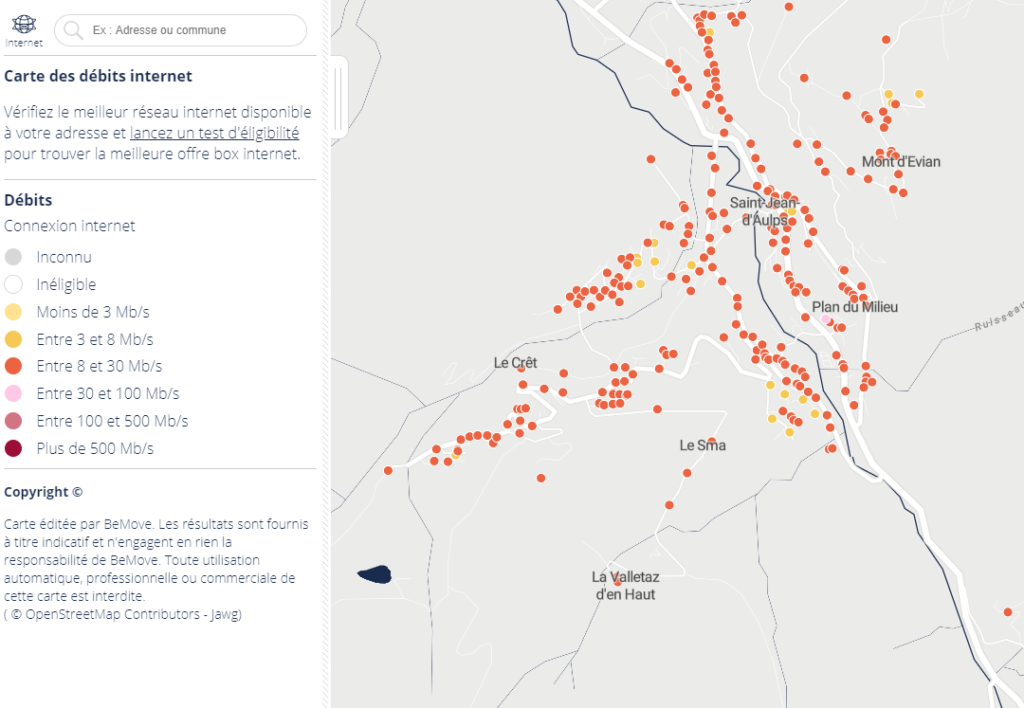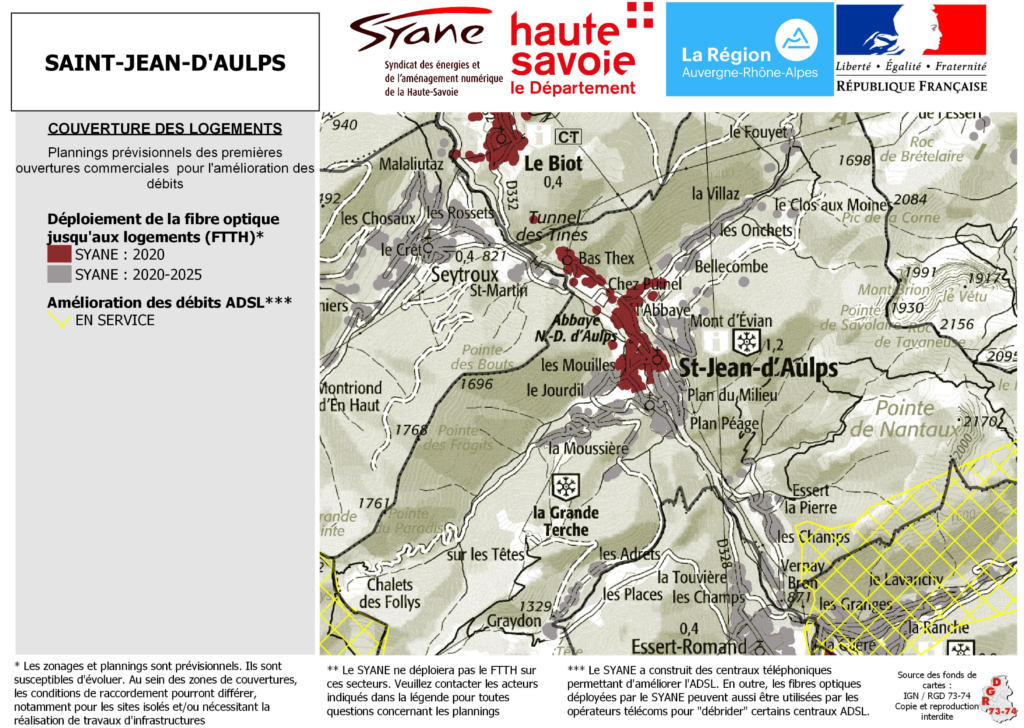This post is also available in: Français (French)
We are 6 months into COVID and it seems that the main effect on the property market in the Alps is to increase demand. I’m not sure I know anyone that would have predicted that at the start. However, it seems obvious now. For those that have been thinking of escaping their homes in the city, this has been the final straw. So it is no surprise that the second question we get asked about a property we have for sale is “how fast is the internet“?
The other COVID effect is to force many people to work from home. That has helped the Alpine Property market too. Because if your home no longer has to be near your work, then you might as well live in the place that you want to spend your free time. In which case you need a good internet connection! I have been working from home in the French Alps for the last 20 years. Without a good internet connection, I can’t work at all. So I’ll share some of my experience here.
If you are looking at a property in the alps to buy then you probably want to know how good the internet is. The estate agent often won’t know. Maybe in this day and age, it should be listed in the particulars! The easiest thing to do is to ask the current owner. Unfortunately most of the time you won’t get an accurate answer. So if you are visiting the property take the time to connect to their internet and go to https://www.speedtest.net/ . Thanks to enormously secure wifi passwords, even this is easier said than done! So that leaves you with making an estimate.
Estimating internet speed.
There are various sites that you can use to check the speed of someone else’s internet. You will often need their fixed-line number. Sometimes an address is enough. https://www.degrouptest.com/ is a good start. Basically what these tests are doing is calculating how far the property is from the telephone “exchange” in the village.
Here are some examples
Property 1
central téléphonique : SEYTROUX
longueur de ligne : 1215 mètres
affaiblissement théorique : 14.01dB
état de la ligne : ACTIVE
débit maximum estimé VDSL2 : 29.3 Mb/s
Property 2
central téléphonique : SAINT‐JEAN D AULPS
longueur de ligne : 2471 mètres
affaiblissement théorique : 38.57dB
état de la ligne : ACTIVE
débit maximum estimé ADSLMAX : 5.6 Mb/s
You can see that property 2 is twice as far from the exchange as property 1. The download speed is 5x slower! That’s par for the course with broadband over telephone lines, and until fibre is installed that is where most of our internet comes from.
If you don’t have the exact address or phone number this map is quite useful. https://www.ariase.com/box/carte-couverture-internet

It simply shows houses close to the exchange in red (10-30 Mbps) or Yellow (5-10 Mbps), it worked for the test above. The first property was in the red zone and the second in the orange zone.
You could stop reading here. However if you want to know a bit more about the numbers please carry on…..
I’ll start with a glossary
- ADSL is a type of broadband internet. If comes into the house on a telephone line.
- Mbps (Megabits per second) is how you measure internet speed.
- 4G is a type of mobile data connection (internet on your phone)
- Fibre or Fibre-optic, sometimes called FTTH, this is super fast internet.
- PING (or latency) is how fast information takes to leave your computer and then return. It is measured in ms (milliseconds)
Many of our properties have a download of around about 5 Mbps, this is normally good enough for watching a movie on Netflix and good enough for using Zoom or the like. However, if there are 5 people in the property trying to do that at the same time it will struggle.
BUT download is only half the story. You download video data to watch a movie. But to use Zoom you need to upload video too. In theory, Zoom will work at 0.5 Mbps up/down. That’s not helpful is it? We’ve thrown in UP AND DOWN. But people only ever talk of downloads. All ADSL internet (so the stuff that comes in on a phone line) downloads faster than it uploads. Usually by a factor 10x . So if you have 5 Mbps download, quite often the best upload you will get is 0.5 Mbps, just about good enough for Zoom. But only just.
Here is the speedtest result for the ADSL in my home

Which you’ll know, if you have read this far, is just enough to get by. However, there are 5 of us in this house and frequently the others are all using the internet at the same time. At which point it is nowhere near enough. I have had to add a 4G connection. With this connection my result is

Which is always good enough. You’ll see that there is another number. A Ping of 47ms. this is “latency” or more simply, this is the delay in sending and receiving the information. The higher that number the longer the pauses required when using Zoom. Anything under 150 is OK. However, it is not good enough for online gaming. the gamers would prefer a Ping of 20 or so.
4G? What’s that?
4G or even better 4G+ is the mobile phone signal. With 4G the difference between the upload and the download is only 2x. As you can see from the numbers above, using 4G improves my upload speed by 40x. If a property is struggling with internet speeds using a 4G box can be an enormous help. A number of us in Alpine Property already do this. It will depend on if you get a good mobile phone signal at your house AND if the phone company has space for you on their system. I know that in St Jean d’Aulps the available slots are full. However, in Le Biot down the road, you can still sign up for a 4G box.
Fibre? Isn’t that coming soon? Won’t it solve the issue?
Yes and Yes! Most of the Haute Savoie is due to be connected to the Fibre optic “soon”, people are being connected now (2020) but you might have to wait until 2025. Syane are undertaking the work and they have a website here https://fibre.syane.fr/eligibilite-de-mon-logement/
They are installing fibre to the home (FTTH). The minimum download will be 100 Mbps, the maximum could be 1000 Mbps (1Gbps), upload at 50+ Mbps. Ping should be less than 20ms. So more than enough for working from home. More than enough for anything really.
When I test my eligibility they say “Vous serez éligible à la fibre entre 2019 et 2025”. This is confirmed by looking at their maps. I live in a grey zone. If you compare this map to the previous map (of current speeds) you will see that they have prioritised properties with really terrible internet. Le Biot is a good example.

Because I rely so heavily on my internet I have kept my ADSL and I have 4G too. I have added a system from OVH that combines these together. This means that if one of the connections is playing up then the other may still be enough. These are connected to one wifi signal that covers the whole house. If the children are clogging everything up I have an app that means I can prioritise my office computer. Obviously, this increases the cost somewhat,
- Bouygues ADSL 25€
- Bouygues 4G 40€
- ovhtelecom.fr/overthebox/ 20€
Total 85€ /month
What if there is no ADSL and no 4G?
Then currently you are left with satellite. Which doesn’t have to be that expensive. Especially when you compare it to the amount I am paying. AND it looks like you can get some help here.
https://www.syane.fr/122-122-1-Amenagement-numerique-%3A-plan-satellite-haut-debit
This site seems to explain the situation well.
https://www.echosdunet.net/en/satellite
The problem with satellite broadband is limited data. Even the “unlimited” plans (70€/month) are capped at 100GB of data. Which for many is fine. Not for my household though. We used 600GB of data last month!
Starlink
As I write this Starlink is not yet operational. It is Elon Musk’s project to connect the entire earth to the internet without wires. This is satellite technology but without the need for a dish. They have just started testing this, so it might be operational in the next few years. It should take over from satellite broadband. It is bound to start out expensive and is most likely going to have data limits. For those who will never get connected to the main networks, this could be the ultimate answer. Take a look at the Wikipedia article for more information.
We’ve talked about this on our YouTube channel too.


